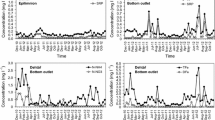Abstract
The aim of the study was to survey the nutrient loads of receiving waters and evaluate the nitrogen, phosphorus and organic matter budget of the conventional fishponds in Hungary. The average nitrogen (N), phosphorus (P) and organic matter (OM) concentrations in the filling-up water of the fishponds were 2.51 ± 1.25, 0.57 ± 0.57 and 23.8 ± 13.4 mg l−1, respectively. Contrarily, the N, P and OM concentrations in the effluents of fishponds were 1.64 ± 2.19, 0.37 ± 0.51 and 30.2 ± 20.5 mg l−1, respectively. The sediment nutrient content in the fishponds during the operation was 5.77 ± 4.42 mg g dry sediment−1 for N, 1.25 ± 0.75 for P and 30.5 ± 43.3 for total organic carbon. The retained nutrients represented on average 53 % (84 kg ha−1 year−1) of N, 74 % (21 kg ha−1 year−1) of P and 74 % (2400 kg ha−1 year−1) of OM, introduced into the fishponds. In the fishponds, the ratio of input N, P and OM accumulated in fish biomass was 18.4 ± 6.7, 10.4 ± 4.4 and 6.8 ± 2.1 %, respectively. The investigated fishponds discharged 48 % less N and 62 % less P into the recipient waters than received with the intake water. However, 78 % more OM was discharged with the effluent from the fishponds than received with the inlet and supplement water.
Similar content being viewed by others
References
Adamek Z, Gál D, Pilarczyk M (2009) Carp farming as a traditional type of pond aquaculture in Central Europe: prospects and weaknesses in the Czech Republic, Hungary and Poland. Eur Aquac Soc Spec Publ 37:80–81
Banas D, Masson G, Leglize L, Usseglio-Polatera P, Boyd CE (2008) Assessment of sediment concentration and nutrient loads in effluents drained from extensively managed fishponds in France. Environ Pollut 152:679–685
FAO FishstatPlus (2013) Universal software for fishery statistical time series. http://www.fao.org/fishery/statistics/software/fishstat/en
Felföldy L (1987) Biológiai vízminősítés. Vízügyi hidrobiológia, 16th edn. Vízgazdálkodási Intézet, Budapest, p 258 (in Hungarian)
Gábor J, Udvari Z, Kiss G, Lukácsik BM (2015) Magyarország tógazdasági és intenzív üzemi haltermelése 2014-ben. Halászat 108(3):3–5 (in Hungarian)
Hlaváč D, Adámek Z, Hartman P, Másílko J (2014) Effects of supplementary feeding in carp ponds on discharge water quality: a review. Aquac Int 22(1):299–320
Knösche R, Schreckenbach K, Pfeifer M, Weissenbach H (2000) Balances of phosphorus and nitrogen in carp ponds. Fish Manag Ecol 7:15–22
Naylor RL, Goldburg RJ, Primavera JH, Kautsky N, Beveridge MCM, Clay J, Folke C, Lubchenco J, Mooney H, Troell M (2000) Effect of aquaculture on world fish supplies. Nature 405(1):1017–1024
Oláh J, Szabó P, Esteky AA, Nezami SA (1994) Nitrogen processing and retention in Hungarian carp farm. J Appl Ichthyol 10:335–340
Scherz H, Senser F (1994) Food composition and nutrition tables. Medpharm Scientific Publishers, Boca Raton, p 435
Schneider O, Sereti V, Eding EH, Vereth JAJ (2005) Analysis of nutrient flows in integrated intensive aquaculture systems. Aquac Eng 32:379–401
Verdegem MCJ (2013) Nutrient discharge from aquaculture operations in function of system design and production environment. Rev Aqauac 5:158–171
Všetičková L, Adámek Z (2013) The impact of carp pond management upon macrozoobenthos assemblages in recipient pond canals. Aquac Int 21:897–925
Author information
Authors and Affiliations
Corresponding author
Additional information
Guest editors: Zuzana Linhartová and Jan Mráz/Carp pond aquaculture, product processing and quality.
Rights and permissions
About this article
Cite this article
Gál, D., Pekár, F. & Kerepeczki, É. A survey on the environmental impact of pond aquaculture in Hungary. Aquacult Int 24, 1543–1554 (2016). https://doi.org/10.1007/s10499-016-0034-9
Received:
Accepted:
Published:
Issue Date:
DOI: https://doi.org/10.1007/s10499-016-0034-9




